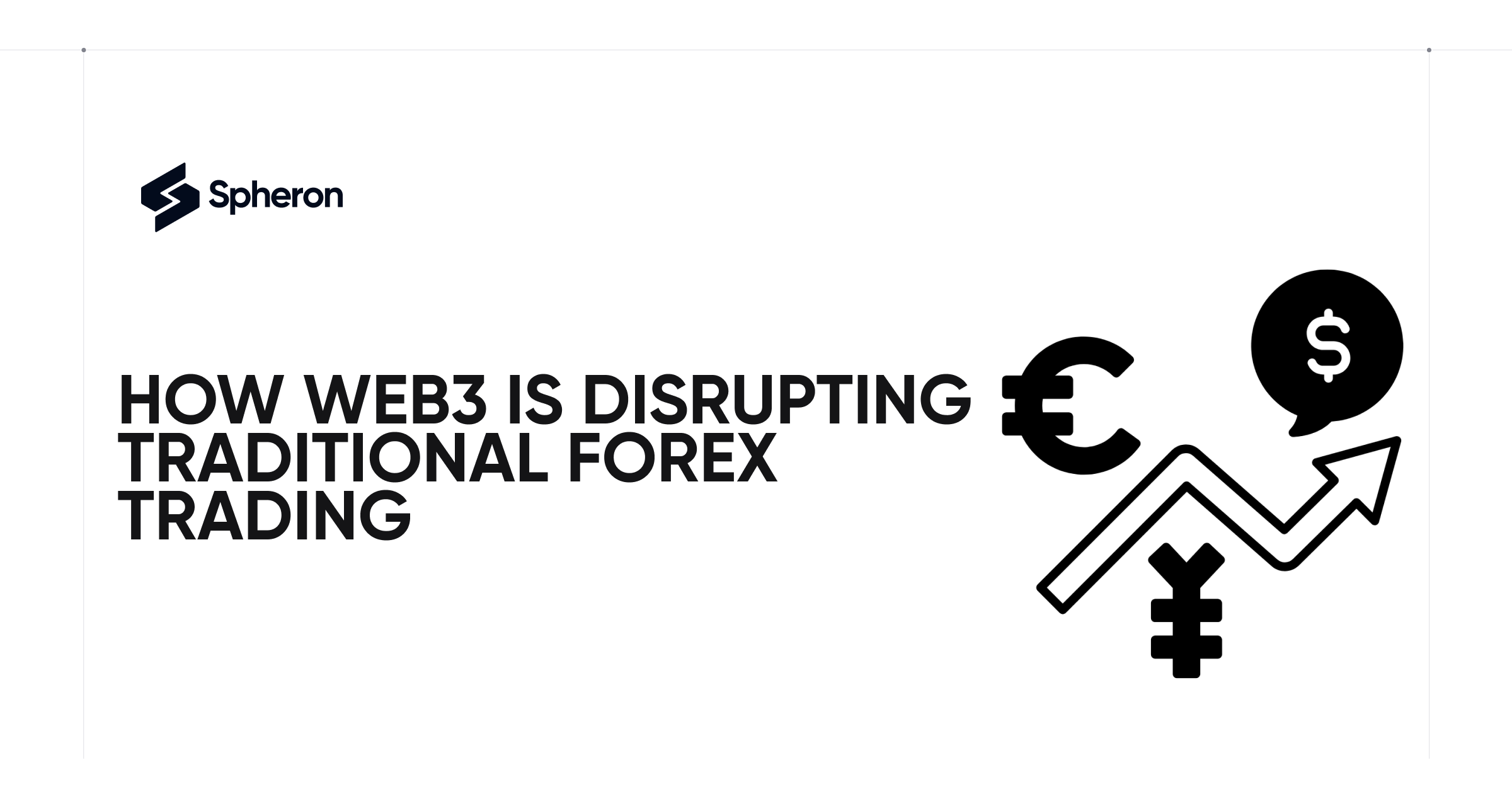How Web3 is Disrupting Traditional Forex Trading
 Spheron Network
Spheron Network
Forex trading, or the foreign exchange market, has long been a lucrative avenue for individuals and institutions to trade currencies. Traditionally, forex trading has been dominated by centralized institutions like banks, brokers, and exchanges, acting as intermediaries between buyers and sellers. These institutions facilitate trades, ensure liquidity, and enforce security protocols, but they also come with certain limitations. The rise of Web3 technology, powered by blockchain and decentralized finance (DeFi), is beginning to disrupt this traditional system. Web3 promises to create a more open, secure, and efficient forex trading ecosystem by eliminating intermediaries, reducing costs, and offering greater transparency and control to traders.
In this article, we will explore how Web3 is transforming the world of forex trading, the benefits it brings, and the challenges it faces in disrupting the established system.
Understanding Web3 and Its Core Principles
Before diving into the ways Web3 is disrupting forex trading, it’s essential to understand what Web3 is and how it differs from the current internet (Web2). Web3 refers to a decentralized internet built on blockchain technology, where users have control over their data and digital assets. Unlike the traditional internet (Web2), where data is stored on centralized servers controlled by corporations, Web3 uses decentralized networks to allow peer-to-peer transactions without intermediaries. This opens up new opportunities for traders, especially those involved in cryptocurrency trading, such as Bitcoin, Ethereum, and others.
Key features of Web3 include:
Decentralization: Control and data are distributed across multiple nodes, ensuring that no single entity holds complete power.
Smart Contracts: Self-executing contracts that automatically execute when certain conditions are met, removing the need for intermediaries.
Tokenization: Assets, including currencies, commodities, and stocks, are tokenized on the blockchain, enabling fractional ownership and seamless transfer.
Security and Privacy: Blockchain’s inherent security features ensure data integrity and privacy, reducing the risks of hacks and fraud.
Web3 is not just a technological shift; it represents a philosophical change towards a more user-centric internet that prioritizes ownership, transparency, and fairness.
The Challenges of Traditional Forex Trading
To appreciate the disruption Web3 brings, it’s crucial to first understand the challenges and limitations of the traditional forex trading system.
Centralized Control: Traditional forex trading platforms rely on brokers, banks, and centralized exchanges. These intermediaries control the flow of information and are often the gatekeepers of the market. As a result, traders are forced to trust these entities to execute their trades fairly. This creates a single point of failure, leaving traders vulnerable to hacks, fraud, or market manipulation by those in control.
Lack of Transparency: Centralized brokers and exchanges often operate as "black boxes," where traders have limited insight into how trades are executed or how pricing is determined. Market manipulation, slippage, and hidden fees are common complaints from forex traders who do not fully understand the forces at play behind the scenes.
High Transaction Costs: In traditional forex trading, brokers and financial institutions charge transaction fees, spreads, commissions, and other hidden costs. These fees, although seemingly small, can add up significantly, especially for high-frequency traders. These costs reduce the overall profitability for traders, especially when margin trading is involved.
Geographical Restrictions and Accessibility: Many forex brokers impose geographical restrictions based on regulations or licensing requirements. This can limit access to traders from certain regions, preventing them from participating in global markets. Additionally, traditional platforms often require a minimum deposit that may be prohibitive for small retail traders.
Slow Settlement Times: In the traditional forex market, settlements can take up to two business days to complete. This delay can be frustrating for traders, especially those looking for quick profits or engaged in short-term trading strategies.
Web3: Revolutionizing Forex Trading
According to CompaForexBrokers.co.za, Web3 is revolutionizing the forex trading landscape by removing intermediaries, increasing transparency, reducing transaction costs, and strengthening security. In this article, we will delve deeper into how Web3 is fundamentally reshaping the way forex trading operates, bringing about significant changes to traditional practices.
1. Decentralization and Peer-to-Peer Trading
One of the most significant advantages Web3 brings to forex trading is decentralization. Traditional forex platforms are centralized and rely on brokers and exchanges to facilitate transactions. However, Web3 enables peer-to-peer (P2P) trading, where users can trade directly with one another without the need for intermediaries. This removes the need for brokers and banks to match buyers and sellers, ensuring a more direct, transparent, and cost-effective trading experience.
Web3-powered decentralized exchanges (DEXs) use blockchain technology to facilitate these trades, enabling trustless transactions. Every trade is recorded on the blockchain, creating an immutable and transparent record of transactions. This ensures that all market participants have access to the same information, reducing the likelihood of market manipulation and providing an equal playing field for all traders.
2. Transparency and Smart Contracts
Transparency is a major issue in traditional forex trading. Many traders feel that the lack of insight into order execution and pricing leaves them at a disadvantage. Web3 addresses this issue by leveraging blockchain’s transparent ledger, which makes all transactions public and accessible. Traders can independently verify the details of each trade, including price, volume, and execution time, allowing for greater trust in the system.
In addition to transparency, Web3 also uses smart contracts, self-executing contracts that automatically fulfill predefined conditions without the need for intermediaries. For example, a forex trade could be executed automatically when certain price conditions are met, removing the need for a broker or exchange to facilitate the transaction. Smart contracts increase efficiency, reduce human error, and ensure that all parties comply with the agreed terms.
3. Lower Transaction Costs
Web3-powered platforms significantly reduce the costs associated with traditional forex trading. Centralized brokers and exchanges charge transaction fees, spreads, and commissions, which can eat into traders' profits. With Web3, these costs are minimized or eliminated because there is no need for a middleman to facilitate the trade. Decentralized exchanges (DEXs) typically charge lower fees for transactions, and with smart contracts executing trades automatically, the need for manual intervention is reduced, further cutting costs.
For example, in the case of Bitcoin and other cryptocurrencies, Web3 allows traders to bypass traditional payment processing networks, which can impose high fees and delays. This makes it possible to execute trades with lower fees and faster settlement times, which is particularly advantageous for high-frequency and short-term traders. Additionally, Web3-based platforms can incorporate bitcoin predictions, offering traders more accurate insights into price movements and helping them make informed decisions based on advanced algorithms and real-time data.
4. Security and Reduced Counterparty Risk
One of the most significant risks in traditional forex trading is counterparty risk. Traders must trust brokers and exchanges to execute trades fairly and securely. However, the centralized nature of these platforms exposes traders to the risk of fraud, hacking, or insolvency if the broker or exchange fails. In contrast, Web3 eliminates this counterparty risk by using decentralized platforms that do not require traders to trust a central authority.
Web3 platforms use blockchain technology to store transaction data in a secure, tamper-proof ledger, ensuring that all trades are executed safely. Additionally, with non-custodial wallets, traders retain full control over their funds and are not required to deposit money into an exchange. This significantly reduces the risk of losing funds due to a platform’s failure.
5. Access to Global Markets
Web3 also offers global accessibility, making forex markets available to a wider range of participants. Traditional forex brokers often impose geographical restrictions, meaning traders in certain countries may not be able to access the same trading platforms as those in more financially developed regions. With Web3, anyone with an internet connection can access decentralized forex platforms, breaking down geographical barriers.
Moreover, Web3 allows traders to engage with digital assets like Bitcoin, Ethereum, and stablecoins, which can be used for cross-border transactions in real-time. By tokenizing currencies and integrating them into decentralized finance (DeFi) protocols, Web3 enables instant, global forex trading without relying on traditional payment systems or intermediaries.
Bitcoin and Web3: A Perfect Pairing for Forex Trading
Bitcoin, the original cryptocurrency, has long been seen as an alternative to traditional fiat currencies. Its decentralized nature and ability to facilitate cross-border transactions make it an ideal candidate for integration into the Web3-powered forex ecosystem. As Web3 grows, Bitcoin and other cryptocurrencies are becoming increasingly important in global forex markets.
In a Web3-powered forex market, Bitcoin can be traded alongside traditional fiat currencies and tokenized assets, allowing traders to diversify their portfolios and gain exposure to both traditional and digital currencies. The use of Bitcoin and other cryptocurrencies on decentralized platforms is already gaining traction, and this trend is expected to grow as Web3 technology becomes more mainstream.
Challenges and the Road Ahead
While Web3 offers numerous benefits to forex traders, challenges remain. Regulatory uncertainty is one of the biggest obstacles to widespread adoption, as many countries are still figuring out how to regulate decentralized platforms and cryptocurrencies. Additionally, the Web3 ecosystem is still in its early stages, and further development is needed to improve scalability, user experience, and security.
Despite these challenges, the future of Web3 in forex trading looks promising. As the technology matures and regulatory clarity emerges, Web3 is poised to reshape the forex trading landscape, offering more transparency, lower costs, and greater security to traders worldwide.
Conclusion
Web3 is poised to disrupt traditional forex trading by offering a decentralized, transparent, and cost-efficient alternative to centralized platforms. By eliminating intermediaries, increasing security, and reducing transaction costs, Web3 enables traders to access global forex markets in a more democratic and user-friendly way. With the integration of digital assets like Bitcoin into Web3-powered platforms, the future of forex trading looks set to evolve into a more inclusive and innovative space. Although challenges remain, the potential for Web3 to reshape forex trading is undeniable, and its adoption will likely continue to grow in the coming years.
Subscribe to my newsletter
Read articles from Spheron Network directly inside your inbox. Subscribe to the newsletter, and don't miss out.
Written by

Spheron Network
Spheron Network
On-demand DePIN for GPU Compute